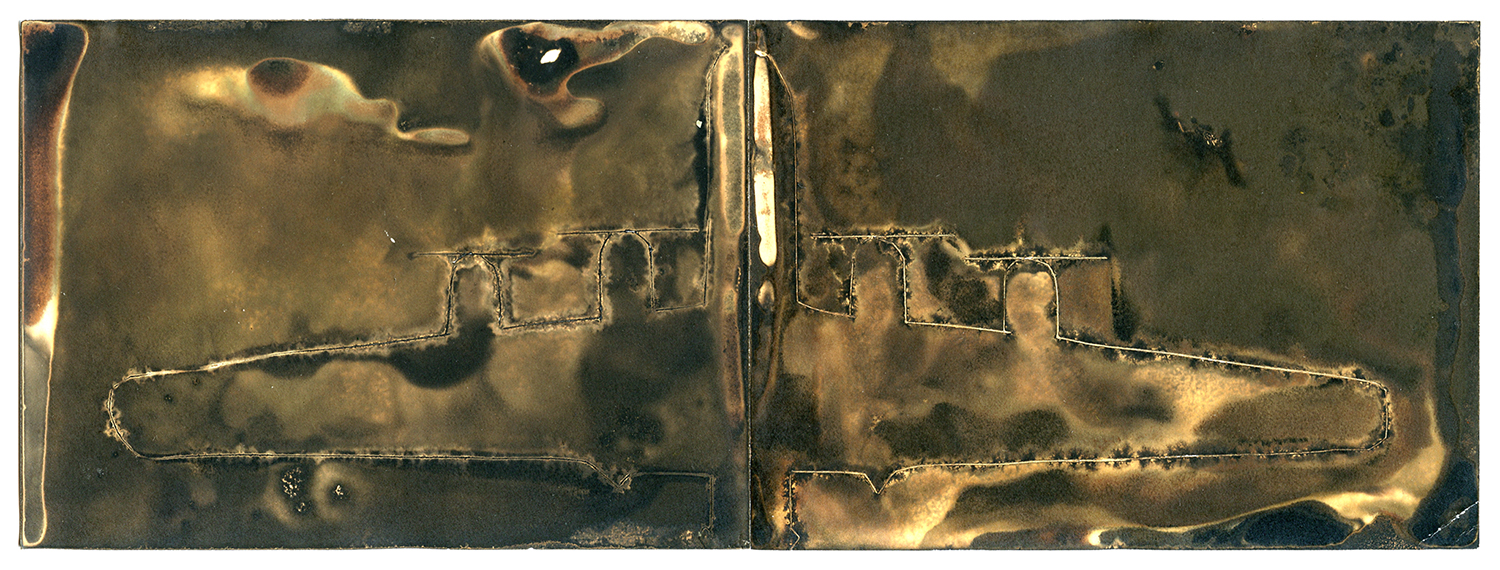One small box of Kodabromide paper. Approximately 120 sheets of 3.25 x 4.5 inch paper. Previously opened but not fogged. The only box out of my collection of this vintage paper with an expiration date falling five days prior to the Hiroshima bombing.
When I created the first Chemigram for Emblem and Artifice 18 months ago, I had no idea where I was going with the project. I initially thought that using my son’s Spirograph on some newly-acquired vintage paper could make some interesting abstract Chemigrams. After fumbling with using the Spirograph on the coated resist, I started pondering the date on the box. I was working with paper that had expired nearly 70 years ago. 70 years. It almost seemed wrong to use it for some idle playing. Having the expiration date so close to that horrific day in August, I decided to try creating an atomic symbol in the resist after several unsuccessful attempts at Spirography.

I was instantly hooked. I had found a new photographic project in the most roundabout way: the materials, in so many ways, defined what my concept would be.
But how do you create knowing that there’s a very tangible end to the project looming on the horizon? Certainly, most artists realize that whatever project they are working on will eventually come to an end – but with only 120 sheets in a box of expired paper, that time seemed uncomfortably close. Creating with Chemigrams, there is no such thing as a “perfect print” – there isn’t a well-defined perfect method of coating the resist or processing the print in developer and fix that will result in the perfect, previsualized image. It relies heavily on an appreciation of serendipitous elements – of chance – and embracing the hope that something amazing comes out of the very few variables you have limited control over.

By choosing to create in (mostly) mirrored diptychs to echo the dual nature of the symbols I’ve chosen, I instantly reduce the possible number of prints for the series down to 60. Initially, I was determined to use any set of prints the process gave me, refusing to reprint symbols, prune the series or try again, no matter how big the failure may be. Fearful of the wastebasket, I kept everything I had out of those first diptychs.
Then? Things fell apart.

I had avoided creating new Chemigrams during last summer – and by the time that I got back to it, my supply of spray resist had changed. Nearly empty and with its nozzle plugged, I coated several pieces of paper poorly and processed them unwisely, resulting in several useless images. Lacking the familiarity of my tools, I had just mowed through four or six pieces of priceless paper.
Undeterred, however, I started up again within a couple days, corrected the issue and created excellent images that fused well with already-created diptychs. Although I didn’t like throwing away the pieces I did because it further limited the size of the final project, it improved the quality of the series. Since then, I have put another 14 pieces of that priceless Kodabromide paper in the reject pile – I have accidentally coated poorly, cut into the resist too lightly and even sliced a couple prints into pieces.

Yet, by doing so, I’ve found a challenging balance between two tensions: when to control and when to let go. Having this finite resource has allowed me to embrace serendipity – without it, I could easily reprint until the process rendered a print to my liking. That’s not to say that I’ve compromised my vision or the quality of the prints – but it does mean that I am a much more careful practitioner. I’ve left behind freedrawing patterns directly on the paper, enlisting the aid of paper guides to avoid poorly-constructed symbols. I’ve taken care to fully coat my images completely with resist. I’ve second-guessed symbols and opted for ones I know I can create with the process. I’m learning about a process that quite literally has no rulebook because each paper, resist and procedure creates a completely new set of variables. It is wonderfully challenging and exhilarating.
I look forward to seeing where the reset of this series takes me.

+There are no comments
Add yours